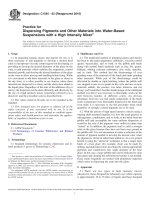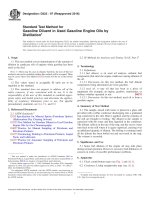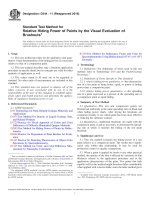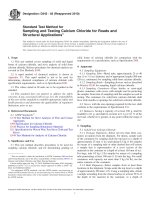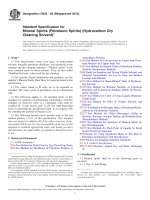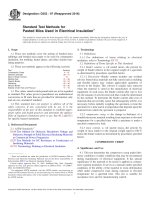Astm d 2259 02 (2016)
Bạn đang xem bản rút gọn của tài liệu. Xem và tải ngay bản đầy đủ của tài liệu tại đây (107.24 KB, 6 trang )
Designation: D2259 − 02 (Reapproved 2016)
Standard Test Method for
Shrinkage of Yarns1
This standard is issued under the fixed designation D2259; the number immediately following the designation indicates the year of
original adoption or, in the case of revision, the year of last revision. A number in parentheses indicates the year of last reapproval. A
superscript epsilon (´) indicates an editorial change since the last revision or reapproval.
1. Scope
D1907 Test Method for Linear Density of Yarn (Yarn Number) by the Skein Method
D2258 Practice for Sampling Yarn for Testing
D3888 Terminology for Yarn Spinning Systems
D3990 Terminology Relating to Fabric Defects
D4031 Test Method for Bulk Properties of Textured Yarns
D4848 Terminology Related to Force, Deformation and
Related Properties of Textiles
D4849 Terminology Related to Yarns and Fibers
E145 Specification for Gravity-Convection and ForcedVentilation Ovens
1.1 This test method is used to determine the shrinkage of
yarns in skein form when treated in boiling water, dry heat,
saturated steam, or solvents. This test method is applicable to
yarns made from any fiber or combination of fibers where the
tex of the yarn is known or can be determined. This test method
is not recommended for elastomeric yarns and those yarns that
stretch more than 5 % under the tension loadings prescribed,
although it has been used for the latter.
NOTE 1—Procedures for determining yarn shrinkage and bulk properties of textured yarns are covered in Test Method D4031.
1.2 This test method shows the values in both SI and
inch-pound units. “SI” units is the technically correct name for
the system of metric units known as the International System of
Units. “Inch-pound” units is the technically correct name for
the customary units used in the United States. The values stated
in either SI units or in other units shall be regarded as standard.
The values expressed in each system may not be exact
equivalents; therefore each system must be used independently
of the other without combining in any way.
1.3 This standard does not purport to address all of the
safety concerns, if any, associated with its use. It is the
responsibility of the user of this standard to establish appropriate safety and health practices and determine the applicability of regulatory limitations prior to use.
3. Terminology
3.1 Definitions:
3.1.1 For definitions of textile terms used in this test
method: skein and skein loop-length, refer to Terminology
D4849.
3.1.2 For definition of the term extension used in this test
method, refer to Terminology D4848.
3.1.3 For other textile terms used in this test method, refer to
Terminology Standards, D123, D3888, D3990, D4848 and
D4849.
4. Summary of Test Method
4.1 The loop length of a conditioned skein of yarn is
measured under a specific tension, which is sufficient to
straighten but not stretch the skein. The tension-free skein is
then immersed in boiling water or exposed to dry heat or
saturated steam or in the solvent reconditioned, and remeasured. The shrinkage (or in some cases, growth) is calculated as
the change in length expressed as a percentage of the length
before immersion or exposure.
2. Referenced Documents
2.1 ASTM Standards:2
D123 Terminology Relating to Textiles
D1059 Test Method for Yarn Number Based on ShortLength Specimens (Withdrawn 2010)3
D1776 Practice for Conditioning and Testing Textiles
5. Significance and Use
5.1 Test Method D2259 for testing yarn for shrinkage in
boiling water, saturated steam, dry heat, or solvents is considered satisfactory for acceptance testing of commercial shipments of yarn because the test method has been used extensively in the trade for that purpose.
5.1.1 If there are differences of practical significance between reported test results for two laboratories (or more),
comparative tests should be performed to determine if there is
a statistical bias between them, using competent statistical
1
This test method is under the jurisdiction of Committee D13 on Textiles and is
the direct responsibility of Subcommittee D13.58 on Yarns and Fibers.
Current edition approved Jan. 1, 2016. Published February 2016. Originally
approved in 1964. Last previous edition approved in 2011 as D2259 – 02(2011).
DOI: 10.1520/D2259-02R16.
2
For referenced ASTM standards, visit the ASTM website, www.astm.org, or
contact ASTM Customer Service at For Annual Book of ASTM
Standards volume information, refer to the standard’s Document Summary page on
the ASTM website.
3
The last approved version of this historical standard is referenced on
www.astm.org.
Copyright © ASTM International, 100 Barr Harbor Drive, PO Box C700, West Conshohocken, PA 19428-2959. United States
1
D2259 − 02 (2016)
known to 1 part in 1000. The hook may have a pointer located
and attached for ease in reading the measuring scale at a point
level with the inside bottom of the skein.
assistance. As a minimum, use the samples for such comparative tests that are as homogeneous as possible, drawn from the
same lot of material as the samples that resulted in disparate
results during initial testing and randomly assigned in equal
numbers to each laboratory. The test results from the laboratories involved should be compared using a statistical test for
unpaired data, a probability level chosen prior to the testing
series. If a bias is found, either its cause must be found and
corrected, or future test results for that material must be
adjusted in consideration of the known bias.
6.4 Tensioning Masses—Accurate to 1 part in 1000.
6.5 For Boiling Water:
6.5.1 Container, of sufficient size for 40:1 mass ratio water
bath.
6.5.2 Roller Wringer or Centrifugal Extractor.
6.5.3 Heat Source, for water bath.
6.5.4 Distilled or Demineralized Water.
6.5.5 Nonionic Wetting Agent.
5.2 Results obtained by this test method can be used for the
following purposes:
5.2.1 As an aid in predicting the dimensional stability of
fabrics to wet processing,
5.2.2 As an aid in predicting the dimensional stability of
fabrics during processing at elevated temperatures, and
5.2.3 As a control measure in the manufacture of some types
of fibers.
6.6 For Dry Heat:
6.6.1 Heating Oven—A forced-draft oven capable of meeting the required temperature and that meets the temperature
uniformity requirements for a Type IIB oven as described in
Specification E145, Table 1. There must be a means of
suspending the skeins in the oven. This may be accomplished
with a rod with cup hooks from which to suspend skeins. The
rod may be mounted on a stand for placement in the oven;
skeins should not be allowed to touch the sides of the oven.
5.3 The shrinkage medium to be used in the test depends on
the requirements of the parties involved.
5.4 The procedure for shrinkage in boiling water is described in Section 12, for shrinkage in dry heat in Section 13,
for shrinkage in saturated steam in Section 14, and for
shrinkage in solvents in Section 15. A 30-min exposure time is
prescribed for boiling water. In exposure to dry heat, saturated
steam, or solvents, the extent of change in the length of yarn is
dependent upon the fiber type and upon the time and temperature of the exposure. Fiber types differ in their reaction to
elevated temperature as well as the nature of the specific
solvent, and prior fiber history can have a great influence upon
the heat and solvent shrinkage of a yarn. Therefore, the time
and temperature conditions to be used to determine dry heat or
saturated steam shrinkage must be agreed upon for the particular product involved. In addition, time and temperature
conditions, and solvent to be used must be agreed upon for
solvent shrinkage determination for the particular product
involved.
6.7 For Saturated Steam:
6.7.1 Autoclave—A pressure vessel capable of sustaining
the temperatures and pressures required, and of such a size that
the test skeins of yarn can be suspended without touching sides
or bottom of the autoclave.
6.8 For Solvents:
6.8.1 Hot Plate or Heated Block—A temperature controlled
hot plate or heated block which can maintain the temperature
of the solvent in a container to 6 2°C or 4°F of the specified
value.
6.8.2 Container, of sufficient size for a 40:1 mass ratio
solvent bath.
6.9 For Drying Wet Skeins:
6.9.1 Drying Oven—A ventilated drying oven maintained at
a temperature of 65 6 3°C or 149 6 5°F, in which the yarn
specimens are not exposed to direct radiation from the heating
elements.
6. Apparatus and Reagents
7. Hazards
6.1 Reel—A hand or motor-driven reel having a nominal
perimeter of 1 m, 1.5 yd, or 1.125 m (Note 2). The reel should
have a traversing mechanism that will minimize bunching of
ends on the reel, a yarn-tensioning device capable of maintaining tension below 1 cN/tex or 1.0 gf/den, and a yarn length or
revolution indicator. A warning bell that will ring just prior to
the specified number of reel revolutions is recommended. A
collapsible arm is advisable for convenience in skein removal.
7.1 Avoid physical contact with hot water and hot metal and
especially saturated steam (Sections 12, 13, and 14).
TABLE 1 Components of Variance as Standard Deviations,
Percentage Points
Properties
Shrinkage, boiling water:
Nylon spun yarn
Nylon filament yarn
Polyester spun yarn
Polyester filament yarn
Acrylic filament yarn
Cotton yarn
Rayon spun yarn
Shrinkage, dry heat:
Nylon spun yarn at 150°C
Nylon filament yarn at 150°C
Polyester spun yarn at 190°C
Polyester filament yarn at 190°C
NOTE 2—By agreement, reels of other perimeters, between 1 and 2 m
(1 and 2 yd) may be used.
6.2 Measuring Scale—A tape or scale accurate to 1 part in
1000 is recommended. Any scale length exceeding the reel
diameter by 250 mm or 10 in. allowing for the extension of the
skein is satisfactory. The scale should be mounted vertically. A
top hook holds the skein and is mounted with support surface
in line with the zero index of the scale.
6.3 Metal Hook—A hook designed to hang from the skein,
shaped to receive the tensioning weights, and with a mass
2
SingleOperator
Component
WithinLaboratory
Component
BetweenLaboratory
Component
0.32
0.20
0.32
0.11
0.22
0.16
0.16
0.60
0.76
0.31
0.32
0.42
0.21
0.25
0.61
0.79
0.26
0.25
0.30
0.19
0.21
0.24
0.20
0.39
0.15
0.23
0.55
0.38
0.65
0.17
0.51
0.26
0.65
D2259 − 02 (2016)
11. Measurement of Skeins
7.2 Refer to manufacturer’s safety data sheets (MSDS) on
the operation of the autoclave. Care should be excercised in
venting the autoclave so that physical contact is not made with
the saturated steam (Section 14).
11.1 Make all skein loop length measurements in the
standard atmosphere for testing textiles which is air maintained
at a relative humidity of 65 6 2 % and at a temperature of 21
6 1°C or 706 2°F.
7.3 Refer to manufacturer’s material safety data sheets
(MSDS) for information on handling, storage, use, and disposal of any solvents used in this test method (Section 15).
11.2 Determine the linear density of the yarn if unknown by
using Test Method D1907 or Test Method D1059. In case of
controversy, results obtained as directed in Test Method D1907
shall prevail.
8. Sampling
8.1 Division into Lots—For acceptance testing purposes,
divide the material to be tested into lots as directed in Practice
D2258.
11.3 Calculate a tension force corresponding to 0.5 cN/tex
or 0.05 gf/den using Eq 1 or Eq 2:
Tension force, cN 5 5.0 3 N 3 T
(1)
8.2 Lot Sample—As a lot sample for acceptance testing, take
at random the number of shipping containers directed in an
applicable material specification or other agreement between
the purchaser and the supplier, such as an agreement to use
Practice D2258.
Tension force, gf 5 0.05 3 N 3 D
(2)
where:
N = number of ends; that is twice the number of wraps in the
skein,
T = yarn number, tex, and
D = yarn number, denier.
NOTE 3—Differences between shipping containers, between packages
within a container, and between specimens within a package are all
sources of variability in test results. A realistic specification or other
agreement between the purchaser and the supplier requires a sampling
plan that considers the relative effects of such sources of variability and
which at the specified limits for shrinkage has a meaningful producer’s
risk, consumer’s risk, acceptable quality level, and lot tolerance fraction
defective.
NOTE 4—For example, an 80-wrap skein has 160 ends. For a 16 tex
yarn, the tension force would be 5.0 × 16 × 160 = 1280 cN = 12.8 N
(0.5 × 16 × 160 = 1280 gf = 1.28 kgf).
11.4 Measure the loop-length of each conditioned skein.
11.4.1 Hang the conditioned skein from the hook at the top
of the measuring scale with the inside of the top of the skein
and the zero index of the scale.
11.4.2 Hang the hook described in 6.3 on the bottom of the
untwisted skein and add sufficient mass (including the mass of
the hook) to produce the force calculated in 11.3.
11.4.3 After 30 6 3 s, measure the inside length of the skein
to the nearest 1 mm or 1⁄16 in.
11.4.4 Record the loop-length of each skein.
8.3 Laboratory Sample—As a laboratory sample for acceptance testing, take a total of ten packages. Select the packages
randomly from all the packages in the lot sampling units.
8.4 Number of Specimens—Test one skein from each package in the laboratory sample.
11.5 Twist each skein into a figure 8 and bring the ends
together to form a two-coil loop. Repeat the procedure to form
a four-coil loop.
9. Preparation of Specimens
9.1 Reel and discard the outer 10 % or 100 m or 110 yd
material from each package.
11.6 Continue as directed in Section 12 for boiling water,
Section 13 for dry heat, Section 14 for saturated steam, or
Section 15 for solvent.
9.2 Reel an 80-wrap skein using a uniform tension of not
over 1 cN/tex or 0.1 gf/den. Lay the yarn smoothly on the reel,
overlap, and loosely tie the beginning and trailing ends of the
skein. To reduce tangling, the skein may be laced loosely. The
number of wraps may be increased or decreased for very fine
or very coarse yarns by agreement of the interested parties.
12. Boiling Water Exposure
12.1 Wrap each skein carefully in cheesecloth and secure
the cheesecloth (sewed, tied) to prevent the entanglement of
the yarn in actively boiling water.
9.3 Identify each skein separately.
12.2 Make up a distilled or demineralized water bath, which
is 40 times the mass of the wrapped skeins, and contains a
0.05 % solution of wetting agent by weight.
10. Conditioning
10.1 Condition the prepared skeins for testing as directed in
Practice D1776, except that preconditioning is not necessary.
Consider equilibrium to have been reached when the change in
mass of the specimen between successive weighings made at
intervals of not less than 2 h does not exceed 0.1 % of the mass
of the specimen.
12.3 Bring the bath to a continuously rolling boil and
immerse the skeins for 30 min.
NOTE 5—A basket may be used to transfer the skeins to and from the
bath.
12.4 Allow the bath to cool to at least 50°C or 122°F before
decanting the solution from the specimens.
12.4.1 Do not cool the bath by overflowing or rinsing the
specimens, because the wetting agent will serve as a lubricant
for the strands in making the final length measurement.
10.2 Condition the prepared skeins for a minimum of 24 h
which is sufficient time for yarn recovery from package
winding tensions as well as to reach the moisture equilibrium
conditions specified in 10.1.
3
D2259 − 02 (2016)
13.6 Recondition the skeins in the standard atmosphere for
textile testing.
NOTE 6—If a basket is used, lift it from the cooled bath, allow the water
to drain until dripping stops and the specimens are cool enough to handle
easily.
13.7 Continue as directed in Section 16.
12.5 Use a centrifuge or roll wringer to damp dry the
wrapped skeins.
14. Saturated Steam Exposure
12.6 Remove the skeins from the cheesecloth and complete
drying them at room temperature or for 1 h in a drying oven at
65 6 3°C or 149 6 5°F.
14.1 Set up the autoclave to produce saturated steam, not
superheated steam. Accomplish this by having a vessel in the
autoclave with sufficient water to contain liquid water in the
vessel throughout the test.
12.7 Recondition each dried skein in the standard atmosphere for testing textiles as directed in 10.1.
12.8 Continue as directed in Section 16.
14.2 Suspend the specimens in the autoclave.
14.3 Heat the autoclave with the vent open, until a temperature of 100°C or 212°F is reached and live steam issues from
the vent. Close the vent and allow the pressure to increase until
the required pressure or temperature, or both, is reached.
13. Dry-Heat Exposure
13.1 Preheat the oven to the selected temperature.
13.2 Shut-off the oven fan, quickly open the door, and
suspend the measured skeins in the oven.
14.4 Expose the specimens to the saturated steam for the
agreed upon time. The shrinkage of a yarn will usually stabilize
in a short time. An exposure time of 15 to 30 min after reaching
the required pressure is recommended.
NOTE 7—Shutting off the oven fan when opening the door reduces the
possibility of entanglement or damage to the skeins.
13.3 Hang the skeins to prevent their touching the bottom or
sides of the oven. Close the door, and restart the oven fan. Keep
the open door time to a minimum.
13.4 When the oven has returned to the selected
temperature, begin measuring the agreed upon exposure time.
14.5 Turn off heat (or steam), allow autoclave to cool until
the pressure is less than 20 kPa (3 psi). Then, vent the
autoclave to atmospheric pressure.
13.5 At the end of this period, shut off the oven fan and
remove the skeins.
14.6 Open the autoclave. Caution: Perform this operation
with extreme care to prevent burns from hot surfaces or steam.
TABLE 2 Critical Differences, Percentage Points for the Condition Noted
Properties
Shrinkage, boiling water:
Nylon spun yarn
Nylon filament yarn
Polyester spun yarn
Polyester filament yarn
Acrylic filament yarn
Cotton yarn
Rayon spun yarn
Shrinkage, dry heat:
Nylon spun yarn at 150°C
Nylon filament yarn at 150°C
Polyester spun yarn at 190°C
Polyester filament yarn at 190°C
Number of Observations in
Each Average
Single-Operator
Precision
Within-Laboratory
Precision
Between-Laboratory
Precision
1
5
10
1
5
10
1
5
10
1
5
10
1
5
10
1
5
10
1
5
10
0.89
0.40
0.28
0.55
0.25
0.18
0.89
0.40
0.28
0.30
0.14
0.10
0.61
0.27
0.19
0.44
0.20
0.14
0.44
0.20
0.14
1.88
1.71
1.69
2.18
2.12
2.11
1.23
0.95
0.90
0.94
0.90
0.89
1.31
1.20
1.18
0.73
0.61
0.60
0.82
0.72
0.71
2.53
2.40
2.39
3.09
3.06
3.04
1.43
1.19
1.16
1.17
1.13
1.13
1.55
1.46
1.44
0.90
0.81
0.80
1.01
0.93
0.92
1
5
10
1
5
10
1
5
10
1
5
10
0.67
0.30
0.21
0.55
0.25
0.18
1.08
0.48
0.34
0.42
0.19
0.13
0.92
0.70
0.67
1.62
1.54
1.53
1.51
1.16
1.11
1.85
1.81
1.81
1.03
0.85
0.82
2.15
2.09
2.09
1.67
1.36
1.32
2.58
2.55
2.55
4
D2259 − 02 (2016)
17.3 Calculate the standard deviation for each laboratory
sampling unit and for the entire lot.
14.7 Remove the specimens and allow them to cool and dry
to room conditions. Recondition the specimens in the standard
atmosphere for testing as directed in 10.1.
18. Report
14.8 Continue as directed in Section 16.
18.1 State that the specimens were tested as directed in Test
Method D2259. Describe the material(s) or product(s) tested
and the method of sampling used.
15. Solvent Exposure
15.1 Wrap each skein carefully in cheesecloth and secure
the cheesecloth (sewed, tied) to prevent entanglement of the
yarn during the solvent exposure.
18.2 Report the following information:
18.2.1 Exposure conditions,
18.2.2 Perimeter of the reel used,
18.2.3 Number of wraps in each skein, if not 80 turns,
18.2.4 Number of packages tested,
18.2.5 The average for each laboratory sampling unit and
for the lot, and
18.2.6 Standard deviation values, if calculated.
15.2 Fill the container to be used with selected solvent. The
mass of the solvent to be used should be 40 times or more than
that of the wrapped skeins.
NOTE 8—Precaution: Solvents should be handled with proper protective equipment such as gloves, eye shields, hoods, etc.
15.3 If the exposure is to be at room temperature, immerse
the specimens in the solvent for the agreed upon time period.
If the exposure is to be at elevated temperature immerse the
specimens in the solvent at the agreed upon temperature for the
agreed upon time period.
19. Precision and Bias
19.1 Interlaboratory Test Data4—An interlaboratory test
was run in 1977, in which randomly drawn samples of three
materials (nylon filament, polyester filament, and acrylic filament) were tested in each of four laboratories. Additional
laboratory tests run in 1979, combined with the 1977 tests in
which randomly drawn samples of four materials (nylon,
polyester, cotton, and rayon spun yarns) were tested in each of
the same four laboratories. Each laboratory used two operators,
each of whom tested two specimens of each of the seven
materials. The media used were dry heat and boiling water. The
components of variance expressed as standard deviations were
calculated to be the values listed in Table 1.
15.4 Decant the solvent from the specimens allowing as
much of the solvent to drain from the yarns as possible.
15.5 Extract as much solvent as possible by squeezing and
damp dry the wrapped skeins. (See 7.2.)
15.6 Dry wrapped skeins for 1 h in an explosion proof
forced-draft oven at 65°C or 149°F maximum, or remove the
skeins from the cheesecloth and dry them under a hood at room
temperature under a hood vented to the outside.
19.2 Precision—For the components of variance listed in
Table 1, two averages of observed values should be considered
significantly different at the 95 % probability level if the
difference equals or exceeds the critical differences listed in
Table 2.
NOTE 9—Drying temperature should not exceed that of the solvent
exposure temperature.
15.7 Recondition each dried skein in the standard atmosphere for testing textiles as directed in 10.1.
16. Remeasurement of Skeins
NOTE 11—The tabulated values of the critical differences should be
considered to be a general statement, particularly with respect to betweenlaboratory precision. Before a meaningful statement can be made about
two specific laboratories, the amount of statistical bias, if any, between
them must be established, with each comparison being based on recent
data obtained on randomized specimens from one sample of the material
to be tested.
16.1 Remeasure skeins as directed in 11.4. Record the
measurement as the final length.
17. Calculation
17.1 Calculate the shrinkage of each skein to the nearest
0.1 % using Eq 3:
Shrinkage, % 5 100 ~ A 2 B ! /A
19.3 Bias—The values for shrinkage of yarns can only be
defined in terms of a test method. Within this limitation, the
procedures in Test Method D2259 for determining those
properties have no known bias.
(3)
where:
A = original loop-length of each skein, and
B = final loop-length of each skein.
20. Keywords
NOTE 10—When B is greater than A due to the elongation of the skein,
the “negative” shrinkage is reported as extension.
20.1 dimensional change; shrinkage; yarn
17.2 Calculate the average for each package, laboratory
sampling unit and for the lot.
4
5
Supporting data are available from ASTM. Request RR:D13-1004.
D2259 − 02 (2016)
ASTM International takes no position respecting the validity of any patent rights asserted in connection with any item mentioned
in this standard. Users of this standard are expressly advised that determination of the validity of any such patent rights, and the risk
of infringement of such rights, are entirely their own responsibility.
This standard is subject to revision at any time by the responsible technical committee and must be reviewed every five years and
if not revised, either reapproved or withdrawn. Your comments are invited either for revision of this standard or for additional standards
and should be addressed to ASTM International Headquarters. Your comments will receive careful consideration at a meeting of the
responsible technical committee, which you may attend. If you feel that your comments have not received a fair hearing you should
make your views known to the ASTM Committee on Standards, at the address shown below.
This standard is copyrighted by ASTM International, 100 Barr Harbor Drive, PO Box C700, West Conshohocken, PA 19428-2959,
United States. Individual reprints (single or multiple copies) of this standard may be obtained by contacting ASTM at the above
address or at 610-832-9585 (phone), 610-832-9555 (fax), or (e-mail); or through the ASTM website
(www.astm.org). Permission rights to photocopy the standard may also be secured from the Copyright Clearance Center, 222
Rosewood Drive, Danvers, MA 01923, Tel: (978) 646-2600; />
6


